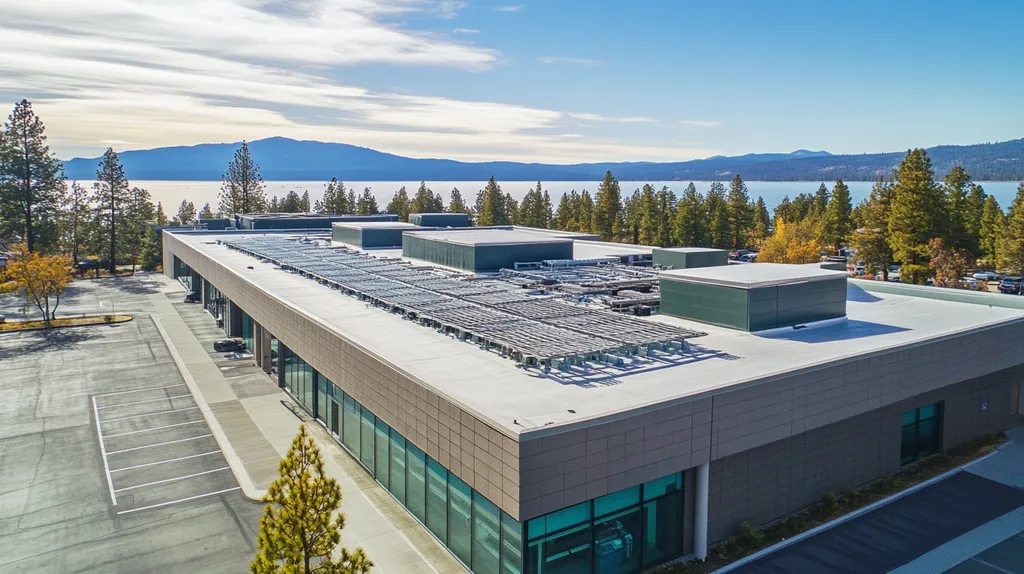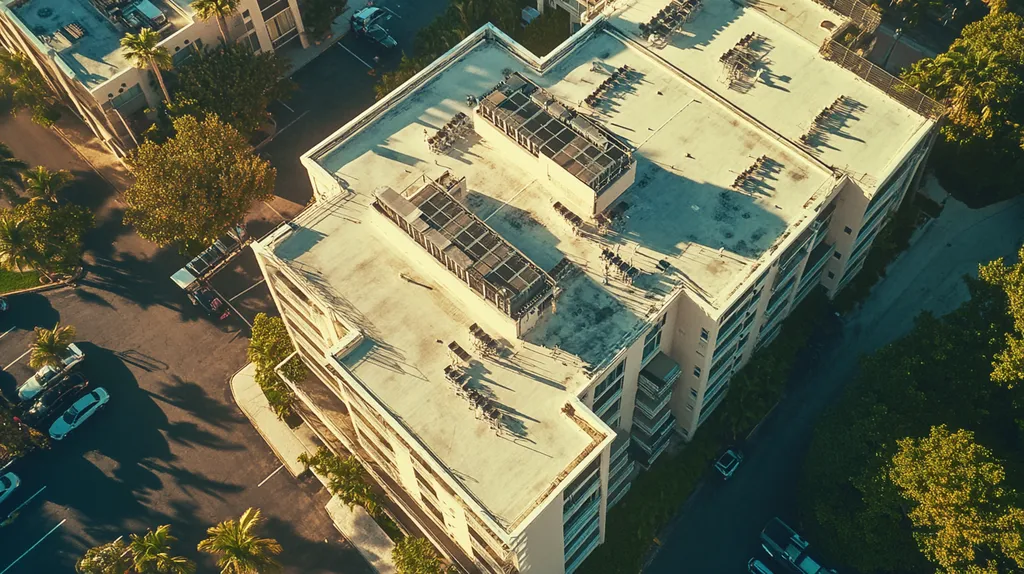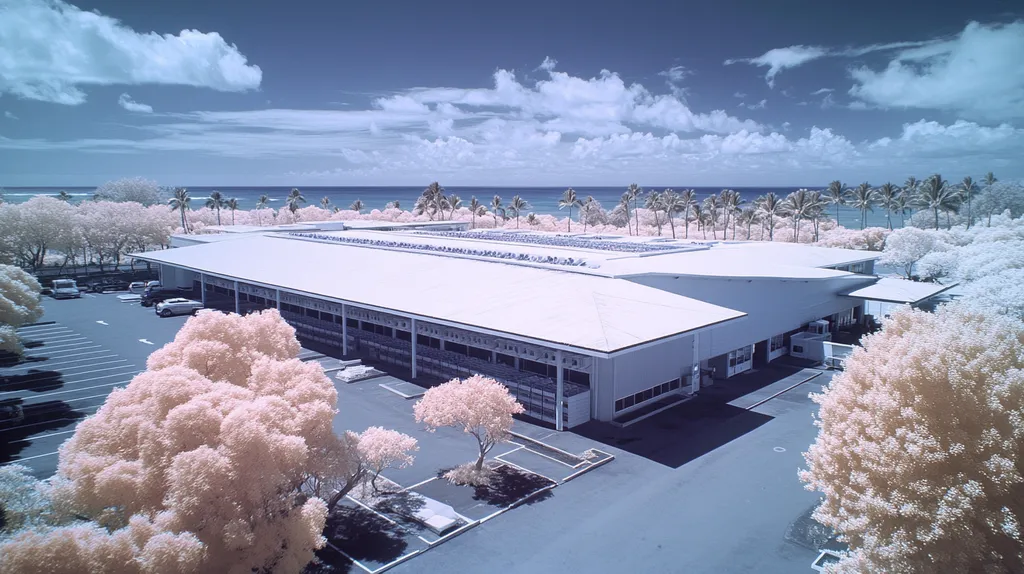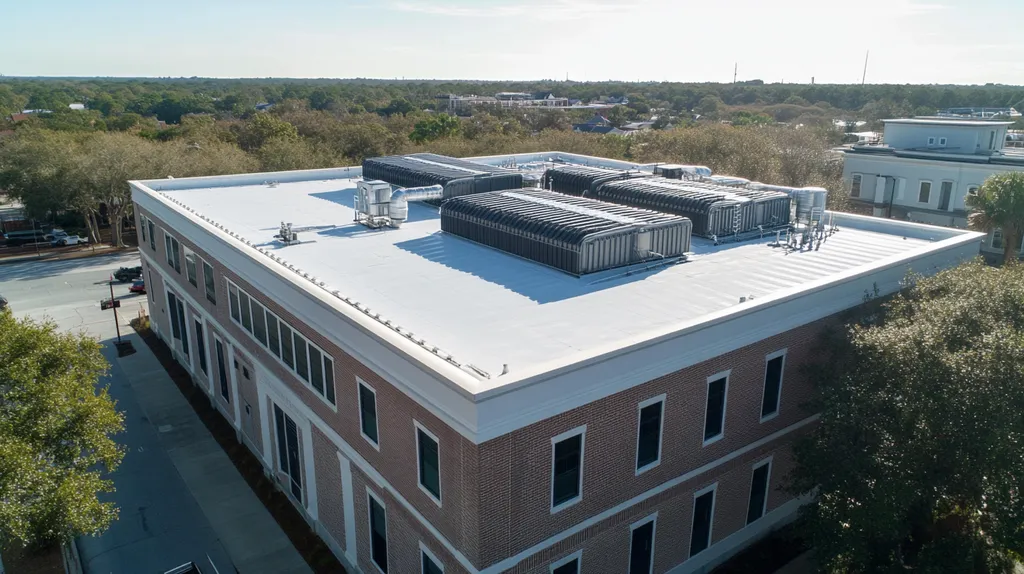In today’s commercial environments, excessive noise can slash workplace productivity by up to 66%, making effective sound insulation a critical priority for property owners and facility managers.
Modern roofing coatings offer a powerful solution, combining advanced acoustic technology with practical implementation methods to create quieter, more productive spaces.
This comprehensive guide explores the essential components of sound-insulating roof coatings, from fundamental acoustic principles to cutting-edge application techniques, helping decision-makers transform their buildings’ uppermost barrier into a powerful asset for noise control.
SECTION 1: FUNDAMENTAL CONCEPTS
Noise pollution in commercial and industrial settings poses a real challenge, affecting everything from productivity to employee morale. Studies show that high noise levels can decrease work efficiency by as much as 66%. To tackle this issue effectively, understanding sound wave dynamics and their interaction with building materials is vitally important. In this section, we’ll explore the basics of sound transmission, the principles of acoustic insulation, and the concept of noise reduction coefficients, equipping property owners with the knowledge needed to make informed choices for sound-insulating coatings.
Sound Wave Dynamics
Sound waves propagate through various mediums, influenced by factors such as frequency and material structure. In commercial buildings, roofs, walls, and floors serve as conduits for these sound waves. Grasping how sound behaves is crucial for effective noise management.
The frequency of sound is particularly important; lower frequencies travel longer distances and are more challenging to block. This highlights the necessity of utilizing coatings engineered specifically to minimize sound transmission.
Common noise sources in industrial environments, including machinery and external traffic, produce unique sound patterns. Each type requires tailored insulation solutions. By understanding these dynamics, property owners can make wiser selections for their roofing systems.
Contemporary roofing solutions now consider sound insulation in addition to weather resistance, emphasizing the need to view roofing materials through a comprehensive lens.
Acoustic Insulation Principles
The primary goal of acoustic insulation is to curb sound transmission by enhancing a material’s ability to absorb sound waves. The fundamental principle is straightforward: increased mass and density generally boost sound absorption capabilities. Fortunately, specialized coatings can significantly enhance a roof’s sound insulation performance.
Two major categories of sound insulation exist: airborne and impact sound insulation. Airborne sounds, like voices and machinery, differ from impact sounds generated by vibrations, such as footsteps. Effective coatings can tackle both types, creating a quieter and more productive work environment.
For example, advanced acoustic coatings can transform an ordinary roof into a formidable sound barrier, adept at absorbing noise at key frequencies. This strategic investment can have profound benefits for commercial properties, fostering improved employee well-being and concentration.
Choosing the right sound-insulating coatings requires careful assessment of both the roof type and specific noise challenges faced by the facility to maximize effectiveness.
Noise Reduction Coefficients
The Noise Reduction Coefficient (NRC) is a vital measure of a material’s sound absorption capacity. Ranging from 0 to 1, where 0 indicates no absorption and 1 signifies complete absorption, a high NRC rating (typically 0.60 or above) indicates effective sound insulation.
Familiarity with NRC ratings empowers property owners to make well-informed decisions regarding roof coatings. Materials with elevated NRC ratings can drastically diminish noise levels, contributing to a quieter indoor atmosphere.
As an example, if a facility experiences significant noise disturbances from adjacent construction, incorporating high-NRC coatings can effectively mitigate this issue, leading to enhanced employee productivity and satisfaction.
Prior to selecting a coating, it’s essential to evaluate how well it aligns with the facility’s unique acoustic needs and performance expectations.
SECTION 2: SYSTEM COMPONENTS
Selecting the right components for sound insulation in commercial roofs is essential for achieving long-lasting building performance. Choosing subpar materials can lead to increased noise pollution, which can diminish tenant satisfaction and productivity. Research indicates that excessive noise can cut employee efficiency by as much as 30%. In this section, we will explore the key criteria for material selection, the significance of fire-retardant features, and the advantages of eco-friendly roofing components.
Material Selection Criteria
Effective sound insulation begins with thoughtful material selection in roofing systems. Characteristics such as density and thickness play a pivotal role in sound absorption. For instance, heavier materials like concrete or specially designed acoustic panels are highly effective at reducing sound transmission.
Coatings that integrate rubber or foam are also beneficial, as they absorb sound waves efficiently, creating a quieter environment within the building. Selecting the right mix of insulation and acoustic treatments is crucial for maximizing performance.
Moreover, compatibility with existing roofing systems must be ensured. A well-integrated system not only prevents failures but also enhances sound insulation while extending the roof’s lifespan.
Additionally, the installation process should not be overlooked. Even the best materials can fail to deliver if installed incorrectly, leading to potential sound leaks and reduced efficiency.
Fire Retardant Properties
Fire safety is non-negotiable in commercial roofing, and coatings with robust fire-retardant properties add significant protection. Fire-resistant roofs enhance building safety and can even lead to lower insurance premiums.
Modern coatings often incorporate fire-retardant chemicals that are designed to slow the spread of flames. For example, intumescent coatings swell when exposed to heat, providing a protective barrier against flames. This crucial feature safeguards the underlying materials and enhances overall building safety.
Fire-resistant coatings are especially important in regions susceptible to wildfires, where they can withstand extreme conditions, thus protecting both the structure and its occupants.
Prioritizing fire-retardant capabilities in sound insulation coatings is not merely about compliance; it represents a proactive strategy for safeguarding investments and ensuring tenant safety.
Sustainability and Eco-Friendliness
With growing environmental awareness, selecting sustainable roofing materials is increasingly important. Eco-friendly coatings enhance sound insulation while also minimizing the building’s carbon footprint.
Materials made from recycled content or those that contribute to LEED certifications reflect a commitment to sustainability. For example, coatings using plant-based resins can reduce reliance on fossil fuels while delivering high performance.
Furthermore, sustainable roofing solutions often result in a longer roof lifespan and lower maintenance costs, reducing waste and aligning with green building practices.
By integrating sustainability into roofing decisions, businesses bolster their corporate social responsibility while gaining a competitive edge. An eco-friendly roof is not just a sound investment; it represents a commitment to operational efficiency and environmental stewardship.
SECTION 3: IMPLEMENTATION METHODS
Achieving effective sound insulation in commercial roofs is not just a matter of choice; it requires precise implementation methods. Without the right techniques, property owners risk increased noise levels that can lead to tenant dissatisfaction and potential business impacts. Studies show that inadequately soundproofed roofs can elevate ambient noise levels by up to 15%. This section will delve into spray application techniques, surface preparation requirements, and the advantages of multi-layer coating systems.
Spray Application Techniques
Utilizing spray application for roofing coatings is one of the most effective strategies for achieving sound insulation in commercial buildings. This method ensures even material distribution, reducing gaps that sound can exploit. For instance, elastomeric coatings can be sprayed directly onto the roof’s surface, creating a seamless barrier that effectively dampens noise.
It’s crucial for property owners to hire experienced professionals for the spray application process. Poor application can compromise insulation quality, undermining the investment. Additionally, this technique shines in high-noise environments, providing both insulation and waterproofing solutions.
Another advantage of spray application is the quick turnaround time on projects. Unlike traditional layering methods, which may require prolonged drying times, spray applications afford immediate coverage and adherence. This can be vital for facilities that must maintain operational functionality while upgrading their roofs.
Incorporating spray application into a broader sound insulation strategy can lead to a significant improvement in noise levels, enhancing tenant satisfaction and overall productivity.
Surface Preparation Requirements
Surface preparation is an essential step in ensuring the longevity and effectiveness of sound insulation coatings. A clean, well-prepped surface maximizes adhesion, allowing coatings to perform their best. It’s important for property owners to address any existing issues—like moisture or debris—before application to avoid potential complications.
For example, removing old coatings or fixing surface irregularities can greatly improve the sound insulation results. If preparation is inadequate, issues such as bubbling or peeling may occur, significantly reducing noise-dampening efficiency. Regular inspections can help identify and fix potential problems before they worsen.
Using abrasive techniques like sandblasting or power washing ensures surfaces are devoid of contaminants. Property managers may find it beneficial to employ specialized contractors who understand the intricacies of sound insulation technologies. By dedicating time and resources to thorough preparation, they can greatly enhance insulation effectiveness.
Thorough surface preparation isn’t merely a procedural step—it’s a critical aspect that significantly influences the success of sound insulation strategies on commercial roofs.
Multi-Layer Coating Systems
Implementing multi-layer coating systems provides a considerable advantage for superior sound insulation. By layering various types of coatings, property owners can design a composite system that enhances both thermal and acoustic performance. For example, a heavy base layer combined with a flexible top layer optimizes sound dampening effectively.
Each layer plays a specific role: the base layer typically absorbs sound waves, while the top layer adds extra protection against environmental conditions. This not only boosts sound insulation but also can extend the roof’s lifespan significantly.
Moreover, these multi-layer systems can be customized based on unique building needs. Property owners can select materials that align with their existing roof types, local climate, and intended use. Collaborating with knowledgeable roofing contractors is crucial for picking the most effective combination of layers.
Ultimately, adopting a multi-layer coating system can transform commercial roofs into soundproof environments, allowing businesses to flourish without disruptions from external noise sources.
SECTION 4: MAINTENANCE REQUIREMENTS
Maintaining commercial roofs with sound insulation coatings is vital for ensuring their long-term performance and effectiveness. Research indicates that roofing systems that are neglected can lead to significant sound leakage, undermining tenant satisfaction and overall energy efficiency. Regular maintenance can proactively prevent these issues, keeping the roof performing optimally. This section discusses essential inspection protocols, effective cleaning and repair methods, and key factors that influence durability.
Regular Inspection Protocols
Routine inspections are essential for catching problems early and maximizing the roof’s lifespan. Property owners should perform visual assessments every six months to spot signs of wear, such as cracks or raised seams. An annual comprehensive inspection by a qualified professional can reveal hidden issues that may otherwise go unnoticed.
Particular attention should be focused on seams, flashings, and areas around penetrations, which are most susceptible to sound leakage. In urban settings, monitoring noise levels during inspections can provide valuable insights into the roof’s sound insulation performance against industry standards.
Establishing a checklist based on local and national regulations can guide thorough evaluations. Implementing a protocol for follow-up inspections after severe weather events is also advisable, as such conditions can exacerbate existing vulnerabilities.
Feedback from tenants and facility managers can serve as an additional resource for identifying issues that may not be immediately visible during inspections. Keeping a detailed record of inspections, including dates and findings, ensures accountability and guides future maintenance strategies.
Cleaning and Repair Methods
Regular cleaning plays a crucial role in maintaining the sound insulation effectiveness of roof coatings. Accumulated debris can impede soundproofing capabilities, making it essential to schedule gentle power washing with approved cleaning agents at least once a year, or more frequently in heavily polluted areas.
When repairs are necessary, using compatible products is vital to ensure proper adhesion and longevity. Patch kits specifically designed for sound insulation coatings can be valuable, but professional application may be required for lasting solutions.
If coating failures occur, stripping the old material and applying a new layer is often more effective than merely patching, ensuring that the roof maintains the required sound insulation ratings.
Documenting all cleaning and repair activities helps monitor the roof’s long-term performance. Analyzing maintenance history can inform future decisions about potential replacements or additional sound insulation measures.
Long-Term Durability Factors
The long-term durability of sound insulation coatings is influenced by various factors, including climate, UV exposure, and the specific use of the building. Coatings in extreme climates may deteriorate more rapidly, necessitating more frequent inspections and adapted maintenance strategies.
UV rays can break down coating materials, reducing their soundproofing effectiveness. Utilizing reflective coatings can help mitigate heat buildup and prolong the coating’s lifespan while enhancing energy efficiency.
Building usage patterns also impact durability. Industries utilizing heavy machinery or experiencing frequent vibrations may see accelerated wear on roofs. Understanding the specific environment around a roof allows for tailored maintenance strategies that effectively address unique stressors.
Employing high-quality coatings from reputable manufacturers can improve the roof’s resistance to adverse conditions. Engaging with manufacturers about warranty details will provide further insights regarding expected lifespan and maintenance best practices.
SECTION 5: PERFORMANCE METRICS
For commercial property owners, understanding performance metrics for sound insulation coatings is not just beneficial—it’s critical. Poorly insulated roofs can lead to tenant dissatisfaction and decreased productivity. In fact, research shows that noisy environments can cut employee efficiency by as much as 15%. This section will highlight essential sound insulation ratings, thermal efficiency, and compliance with industry standards, providing property owners with the knowledge needed to make informed roofing decisions.
STC and NRC Ratings
The Sound Transmission Class (STC) and Noise Reduction Coefficient (NRC) ratings are two essential metrics for assessing sound insulation effectiveness. STC measures how well a building component, such as a roof, reduces airborne sound. A higher STC rating indicates better soundproofing. For example, a roof with an STC rating of 50 significantly cuts down noise from rain and wind compared to one rated at 30.
Conversely, NRC evaluates the extent to which a material absorbs sound rather than allowing it to pass through. A roof boasting an NRC rating of 0.9 absorbs 90% of incoming sound, making it a great choice for settings like offices or recording studios. Knowing both metrics equips property owners to select options that best address their unique noise challenges.
When comparing products, examining both STC and NRC ratings provides a complete picture of a coating’s sound insulation prowess. Prioritizing high ratings ensures maximum comfort for occupants and effective protection from disruptive noise.
Thermal Insulation Efficiency
Alongside sound insulation, the thermal insulation efficiency of coatings is crucial for comprehensive roof evaluation. A well-insulated roof not only dampens sound effectively but also stabilizes indoor temperatures, ultimately contributing to energy savings. Certain coatings can drastically reduce heat transfer, which lowers HVAC costs.
The R-value, a standard measure of thermal resistance, dictates that higher values equate to better insulation. Property owners should seek coatings that combine robust sound insulation with competitive R-values. This dual function is especially important in areas with extreme weather conditions.
Investing in coatings that excel in both sound and thermal insulation leads to a more comfortable space for occupants while minimizing energy consumption. These advantages result in lower operating costs and enhanced overall building performance.
Compliance with Industry Standards
Maintaining adherence to industry standards is vital for ensuring the efficacy and reliability of sound insulation coatings. Most coatings must comply with specific guidelines set by organizations like the American Society for Testing and Materials (ASTM) and Underwriters Laboratories (UL). Compliance not only guarantees performance but also boosts a property’s marketability.
Manufacturers typically provide documentation to confirm compliance, which can be crucial during the selection process. Property owners should prioritize products certified by recognized entities to avoid risks associated with inferior materials.
Choosing compliant coatings can simplify building inspections and future audits. Meeting regulations positively influences a property’s reputation, potentially increasing its appeal to prospective tenants.
SECTION 5: PERFORMANCE METRICS
For commercial property owners, grasping the performance metrics of sound insulation coatings is crucial not only for tenant satisfaction but also for maintaining productivity. Research reveals that inadequate sound insulation can lower employee efficiency by up to 15%. In this section, we’ll dive into essential sound insulation ratings, thermal efficiency metrics, and the importance of compliance with industry standards, equipping decision-makers with the insights needed for sound roofing choices.
STC and NRC Ratings
Understanding Sound Transmission Class (STC) and Noise Reduction Coefficient (NRC) ratings is fundamental for assessing sound insulation effectiveness. STC measures how well a roofing element can reduce airborne sound levels. A higher STC rating signifies better soundproofing capability, making it essential for productive work environments. For instance, a roof with an STC rating of 50 significantly diminishes noise from rain and wind compared to a roof rated at 30.
NRC, in contrast, gauges how much sound a material absorbs rather than allowing it to pass through. A roof boasting an NRC rating of 0.9 captures 90% of incoming sound, making it especially suitable for settings such as offices or recording studios. Familiarity with both metrics enables property owners to select solutions that best align with their unique noise challenges.
When evaluating products, it’s vital to consider both STC and NRC ratings collectively. This comprehensive view ensures that property owners choose materials that provide an optimal sound insulation experience, maximizing comfort for occupants while keeping disruptive noise at bay.
Thermal Insulation Efficiency
Alongside sound insulation, a roof’s thermal insulation efficiency plays a critical role in its overall assessment. A well-insulated roof not only reduces noise but also helps stabilize indoor temperatures, resulting in energy savings. Certain coatings can significantly minimize heat transfer, which in turn lowers HVAC operating costs.
The R-value, a common measure of thermal resistance, indicates that higher values equate to more effective insulation. Property owners should seek coatings that offer excellent sound insulation alongside competitive R-values. This dual capability is particularly essential in climates known for extreme weather, where energy efficiency becomes even more vital.
Investing in coatings that excel in both sound and thermal insulation creates a more comfortable environment for occupants, leading to reduced energy consumption. These efficiencies ultimately lead to lower operating costs and improved building performance, delivering value for property owners and tenants alike.
Compliance with Industry Standards
Adhering to industry standards is vital for the efficacy and reliability of sound insulation coatings. Many products must conform to guidelines established by organizations such as the American Society for Testing and Materials (ASTM) and Underwriters Laboratories (UL). Compliance not only ensures performance but also enhances a property’s marketability.
Manufacturers typically provide documentation confirming compliance with these standards, a critical factor in the decision-making process. Property owners should prioritize materials certified by reputable organizations to mitigate the risks associated with substandard products.
Selecting compliant coatings simplifies building inspections and enhances future audits. Meeting regulatory standards not only reinforces a property’s credibility but can also boost its attractiveness to potential tenants, increasing its overall value in the market.
Looking Ahead
With workplace noise pollution causing up to 66% productivity loss, sound-insulating roof coatings have become an essential investment for forward-thinking property owners.
Modern coating technologies now deliver unprecedented acoustic performance while addressing critical needs like fire resistance, sustainability, and thermal efficiency.
The integration of proper surface preparation, strategic application methods, and rigorous maintenance protocols ensures these systems perform optimally throughout their lifecycle.
As urban environments grow increasingly noisy, properties equipped with effective sound insulation will command premium values and attract quality tenants.
By implementing the strategies outlined in this guide, facility managers can transform their roofing systems into powerful assets that protect occupant wellbeing while delivering measurable returns on investment.
FREQUENTLY ASKED QUESTIONS
Q. What is sound transmission in commercial roofs?
A. Sound transmission refers to how sound travels through building materials. Understanding this concept helps property owners choose effective coatings that reduce noise levels significantly, leading to improved comfort and productivity.
Q. How does material selection affect industrial roof insulation?
A. Material selection plays a key role in sound insulation. Heavier and denser materials absorb sound better, while coatings with rubber or foam enhance sound absorption, reducing noise pollution and improving workplace morale.
Q. What are effective methods for applying sound insulation coatings on commercial roofs?
A. Spray application techniques ensure even coverage and reduce sound gaps. Preparation of the surface is critical to ensure proper adhesion, while professional application maximizes effectiveness, leading to significantly enhanced sound insulation.
Q. How often should commercial roofs with sound insulation coatings be inspected?
A. Routine inspections every six months help catch potential issues early. An annual inspection by professionals ensures any hidden problems get addressed, maintaining optimal acoustic performance and extending the roof’s lifespan.
Q. What performance metrics should I consider for commercial roof insulation?
A. Key metrics include Sound Transmission Class (STC) and Noise Reduction Coefficient (NRC) ratings. These ratings indicate how well a roof reduces noise and absorbs sound, helping you choose the best insulation for your needs.
Q. How do fire-retardant properties affect coatings on commercial roofs?
A. Fire-retardant properties enhance safety and can lower insurance costs. Coatings that resist flames help protect structural integrity and maintain sound insulation effectiveness, making them crucial in fire-prone areas.
Q. What is the advantage of multi-layer coating systems for sound insulation?
A. Multi-layer systems create a composite that enhances both thermal and acoustic performance. By combining different coatings, property owners can maximize sound absorption while ensuring greater protection from weather and environmental factors.











